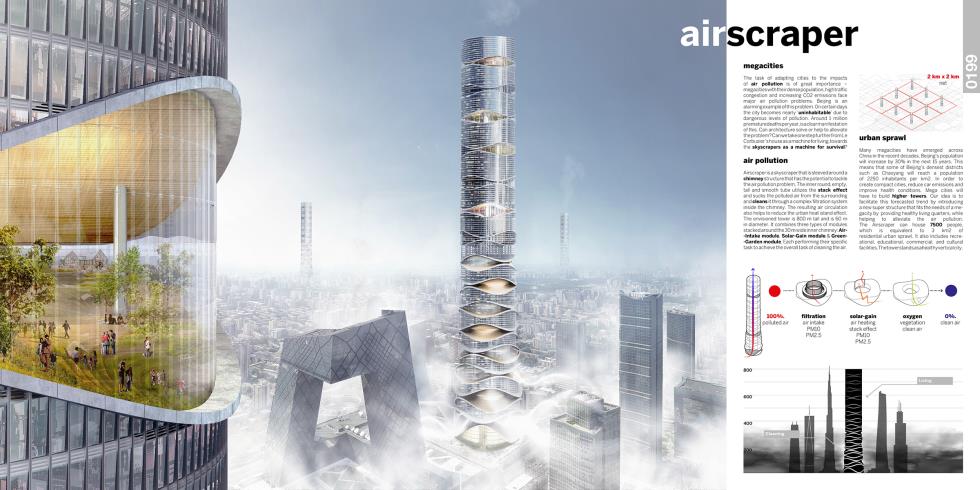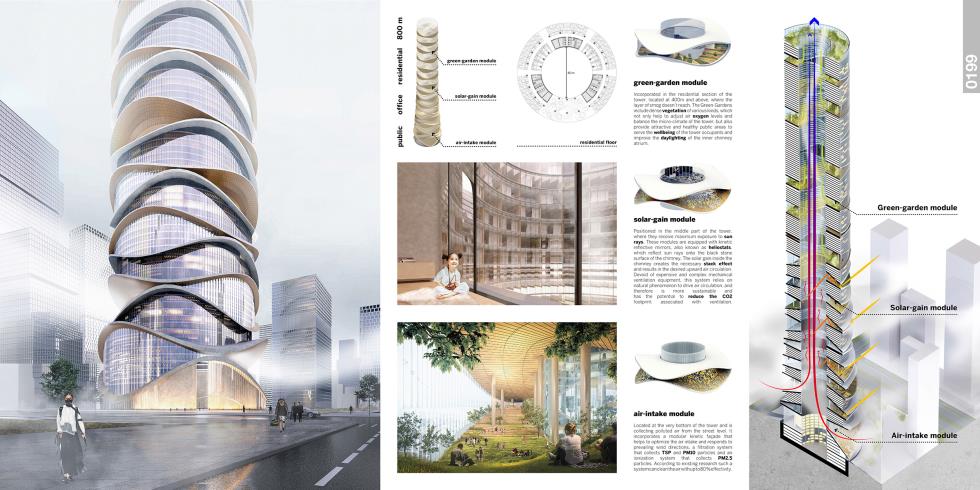Second Place
2019 Skyscraper Competition
Klaudia Gołaszewska, Marek Grodzicki
Poland
The task of adapting cities to the impacts of air pollution is of great importance – megacities with their dense population, high traffic congestion and increasing CO2 emissions face major air pollution problems. Beijing is an alarming example of this problem. On certain days the city becomes nearly ‘uninhabitable’ due to dangerous levels of pollution. Around 1 million premature deaths per year, is a clear manifestation of this. Can architecture solve or help to alleviate the problem? Can we take one step further from Le Corbusier’s house as a machine for living, towards the skyscrapers as a machine for survival?
Air pollution
Airscraper is a skyscraper that is sleeved around a chimney structure that has the potential to tackle the air pollution problem. The inner round, empty, tall and smooth tube utilizes the stack effect and sucks the polluted air from the surrounding and cleans it through a complex filtration system inside the chimney. The resulting air circulation also helps to reduce the urban heat island effect. The envisioned tower is 800 m tall and is 60 m in diameter. It combines three types of modules stacked around the 30 m wide inner chimney: Air-Intake module, Solar-Gain module & Green-Garden module. Each performing their specific task to achieve the overall task of cleaning the air.
AIR-INTAKE MODULES are located at the very bottom of the tower and is collecting polluted air from the street level. It incorporates a modular kinetic façade that helps to optimize the air intake and responds to prevailing wind directions, a filtration system that collects TSP and PM10 particles and an ionization system that collects PM2.5 particles. According to existing research such a system can clean the air with up to 80 % effectivity.
SOLAR-GAIN MODULES are positioned in the middle part of the tower, where they receive maximum exposure to sun rays. These modules are equipped with kinetic reflective mirrors, also known as heliostats, which reflect sun rays onto the black stone surface of the chimney. The solar gain inside the chimney creates the necessary stack effect and results in the desired upward air circulation. Devoid of expensive and complex mechanical ventilation equipment, this system relies on natural phenomenon to drive air circulation, and therefore is more sustainable and has the potential to reduce the CO2 footprint associated with ventilation.
GREEN-GARDEN MODULES are incorporated in the residential section of the tower, located at 400m and above, where the layer of smog doesn’t reach. The Green-Gardens include dense vegetation of various kinds, which not only help to adjust air oxygen levels and balance the micro-climate of the tower, but also provide attractive and healthy public areas to serve the wellbeing of the tower occupants and improve the daylighting of the inner chimney atrium.
Urban sprawl
Many megacities have emerged across China in the recent decades. Beijing’s population will increase by 30% in the next 15 years. This means that some of Beijing’s densest districts such as Chaoyang will reach a population of 2250 inhabitants per km2. In order to create compact cities, reduce car emissions and improve health conditions, Mega cities will have to build higher towers. Our idea is to facilitate this forecasted trend by introducing a new super structure that fits the needs of a megacity by providing healthy living quarters, while helping to alleviate the air pollution. The Airscraper can house 7500 people, which is equivalent to 3 km2 of residential urban Sprawl. It also includes recreational, educational, commercial, and cultural facilities. The tower stands as a healthy vertical city.
Future skyscrapers
In our opinion, the 21st century skyscraper is an urban super structure that not only serves the local needs of occupants and fulfils the economic expectations of investors, but also bears a global responsibility towards the city below and the planet around.

